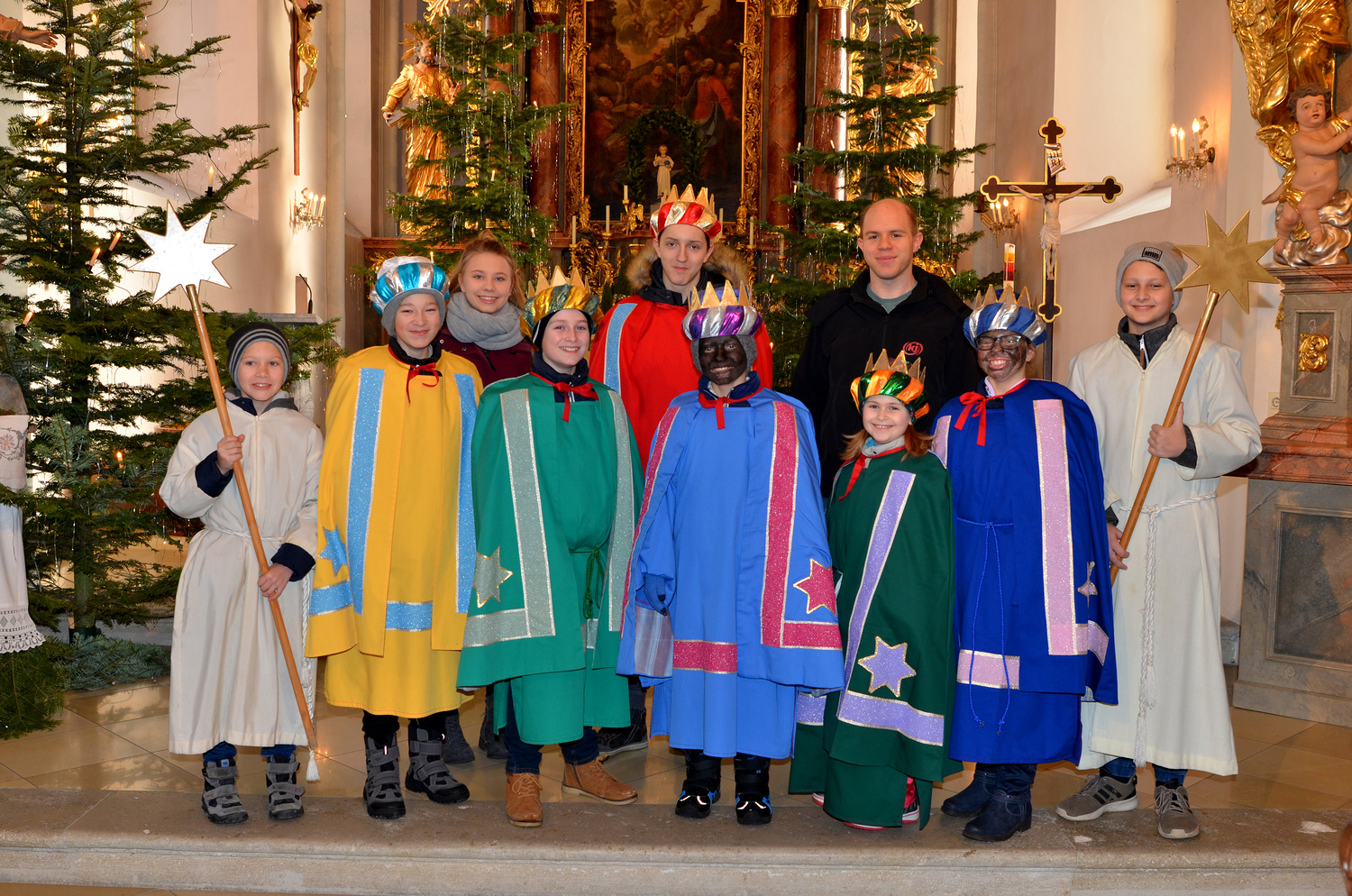Proclamation of Feasts
Today we take our calendars for granted, but in former ages it was not so. Early Christians relied on the calculations of scholars from Alexandria (considered the most competent) to determine the date of Easter, which falls on the first Sunday after the vernal equinox. Those calculations would be solemnly announced on the Epiphany, which was a sensible choice since the feast celebrates an astronomical event, and it is not far from the seasons of Lent and Easter. The chant used for the proclamation, which is the same as that of the Easter Vigil Exultet, is called the Noveritis.
Did you know that the theater in the Western world, after it died out in ancient Greece and Rome, was brought back to life by the worship of the Church? The earliest medieval plays began as theatrical reenactments of Gospel passages of the day (Easter, Good Friday, etc). Epiphany had an “Office of the Star” tied to the liturgy of the feast and staged in the sanctuary of the church, but over time it grew out of hand. The character Herod was portrayed as a raging lunatic, overthrowing furniture and beating clergy and laity alike with a wooden stick. Church officials decided to ban the play from the sanctuary, at which point it moved outside and became a popular medieval entertainment. William Shakespeare remembered these plays from his childhood, before they were banned by England’s Protestant leaders. In Hamlet, the young prince declares that overacting “out-Herods Herod” (III.ii.13). Tamer versions of the medieval Epiphany play continue to exist in the German tradition of Sternsingen and the Spanish tradition of the festival of Los Tres Rejes.

Sternsingen 2019 (Blackface not recommended)
Blessing of Homes
An even older custom is the blessing of one’s home on the Epiphany. A priest comes to the house, sprinkles each room with holy water, and incenses them.
But the more common practice is the blessing of one’s house with chalk. At church the priest blesses chalk and sprinkles it with holy water, saying:
Bless, O Lord God, this creature chalk, that it may be salutary for mankind; and, through the invocation of Thy most holy name, grant that whoever obtains some of it or writes with it upon the doors of their home the names of Thy saints, Caspar, Melchior and Balthasar, may, through their intercession and merits, receive health of body and protection of soul. Through Christ our Lord. ℟. Amen.
The faithful then take the chalk home with them and write on the lintel of their doors the current year along with the letters C, M, and B, interspersed by crosses—e.g., 20+C+M+B+22.
Because it is a product of clay, chalk is a fitting symbol for the human nature assumed by the Word whose incarnation we celebrate this season. The year signifies the time that has elapsed since the Savior’s birth into human history, the crosses represent Christ Himself and the holiness of the Magi, and the letters represent the initials of the three kings: Caspar, Melchior, and Balthasar. These same letters can also stand for Christus mansionem benedicat—May Christ bless this house.
Blessing the home on Epiphany is appropriate. Just as the wise men visited the temporary home of the Infant Jesus and brought Him gifts of gold, frankincense, and myrrh (symbols of His kingship, divinity, and burial), so too do we pray that Christ may visit our temporary (earthly) home with gifts of grace and peace for ourselves and our guests.
Epiphany Carols
People are (or at least used to be) still in a caroling mood on Epiphany. One noteworthy custom is the star carol. From the fourteenth century to the Reformation, groups would go from house to house holding the Star of Bethlehem and announcing through song that they were the Magi telling of their adventures. The custom, which was a simplified form of the medieval Epiphany play, still exists in Austria and Bavaria (where it is called Sternsingen) and in Slavic countries.
We suspect that the author of the most popular Epiphany carol in the English language and perhaps the world was aware of this tradition. John Henry Hopkins, Jr. was rector of Christ Episcopal Church in Williamsport, Pennsylvania and the music teacher at the General Theological Seminary in New York City. For his final year of teaching at the seminary (1857), he wrote “We Three Kings” for a Christmas pageant they were having. Hopkins wrote both the music and the lyrics for the song which was rare: usually, the lyrics were written by one person and the tune by another. The carol also holds the honor of being the first Christmas-Epiphany carol from the United States achieving worldwide popularity: even the British and the French like it. The song aptly impersonates all three kings in the first verse, Melchior in the second, Balthasar in the third, and Caspar in the fourth, while the chorus praises the Christmas Star. By the time the carol is over, the singer or hearer knows who the three kings are, what gifts they brought, and what deeper meaning the gifts have. Written in the distinctive Aeolian mode, it smacks of music from the Middle Ages and Middle East. The first verse is:
We three kings of Orient are;
Bearing gifts we traverse afar,
Field and fountain,
Moor and mountain,
Following yonder star.
Gift-Giving
In Italy and Spanish-speaking countries, Epiphany rather than Christmas is the occasion for exchanging gifts. In Italy, the old woman Befana brings the presents; in Spanish-speaking countries, is the Magi.
Some cultures split the difference and exchange gifts on both Christmas and Epiphany. In French Canada, Epiphany was nicknamed “Little Christmas.” The practice of opening presents over a period of days makes sense, since children who open all their gifts in a mad frenzy on Christmas morning often become unappreciative and lethargic afterwards.
Befana, a corruption of the word “Epiphany,” gives gifts to children in Italy on her feast day
Blessing of Water
As we mentioned earlier, Epiphany also celebrates the Baptism of Jesus in the Jordan, which according to Catholic and Orthodox belief is the moment when Christ sanctified water, making it capable of communicating the grace of the sacrament of baptism. It is therefore customary to bless water on this day. The Roman Catholic Church has a traditional and elaborate blessing of water that takes place on the eve of Epiphany and requires, among other things, several exorcisms and infusing the water with a little salt.
Other Christian churches use this occasion to bless natural bodies of water. In the Holy Land, after the River Jordan is blessed, thousands plunge themselves into the water three times to receive a blessing. In Egypt, the same thing traditionally happens in the Nile; locals also lead their domestic animals into the river for a blessing and dip their religious objects into the river for the same reason. After the priest blesses a body of water, he throws a cross into it. The men of the town then compete to retrieve it; the one who does has good luck for the year. And the blessing has the added advantage of driving away the Christmas demons. The Greeks also use occasion to bless their boats and ships.
Food and Drink
The signature food for Epiphany (or, sometimes, the night before) is King’s Cake. A small object is put in a cake. Traditionally, it was a coin; more recently, it is a small figurine of the Infant Jesus. Whoever finds the object in their piece of the cake is king of the merry party. In Austria, Germany, France, England, and Canada, the King’s Cake contained a bean and a pea; finding the bean made one a king while the pea made one a queen.
The custom was also tied to charity. In France a piece of cake was put aside “for our Lord” and given to a poor person. Another French tradition required each person to pay for his piece of cake. The money collected, called “the gold of the Magi,” would be given to the poor or to help pay for the education of a promising but disadvantaged youth.
In Mexico, rosca de Reyes or Kings’ Day Bread is a wreath-shaped loaf with cinnamon, anise seed, vanilla extract, and dried fruit. The dinner guest who finds the Baby Jesus in his slice must make the tamales for the next gathering. A similar custom exists in Spain. Roscón de Reyes is a delicious oval, cream-filled pastry with a hidden bean and a surprise. Whoever finds the surprise gets good luck for the year; whoever finds the bean has to buy the next roscón.





